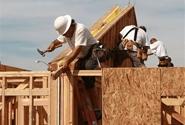Steel Markets

Housing Starts Off to a Good Start in January
Written by Sandy Williams
February 16, 2018
Housing starts in January jumped 9.7 percent from December to a seasonally adjusted annual rate of 1,326,000, according to data released by the Department of Commerce. Construction of homes of five units or more surged 19.7 percent, while single-family starts climbed 3.7 percent.
Starts increased across three of the four U.S. regions, but dropped by 10.2 percent in the Midwest. Starts in the Northeast soared 45.5 percent for a total of 128,000 units compared to 88,000 in December.
Permit authorizations were at a seasonally adjusted annual rate of 1,396,000, a 7.4 percent rise from both the previous month and January 2016. Building permits for single-family homes declined 2.7 percent, but multi-unit permits jumped by double-digit percentages—37.8 percent for 2-4 units and 25.4 percent for five units or more.
Permit authorizations grew 21.9 percent in the South and 3.5 percent in the West. Permit authorizations fell 16.9 percent in the Northeast and 11.7 percent in the Midwest. Most of the gains were for multi-unit construction.
“The growth in production is in line with our reports of solid builder confidence in the housing market,” said National Association of Home Builders Chairman Randy Noel. “A pro-business regulatory climate and increasing housing demand are boosting builders’ optimism, even as they continue to face supply-side hurdles such as rising construction material prices and access to lots and labor.”
NAHB Chief Economist Robert Dietz noted the “three-month moving average for single-family starts was near a post-recession high rate of construction (890,000).”
“Demand for owner-occupied housing is rising due to favorable demographic tailwinds and a healthy labor market. Increases in after-tax incomes should help prospective buyers save for a downpayment on a home,” said NAHB Chief Economist Robert Dietz. “As consumers continue to enter the single-family market, we should see builders increase production to meet this demand.”

Sandy Williams
Read more from Sandy WilliamsLatest in Steel Markets

USW cheers Evraz NA agreement with Atlas Holdings
The United Steelworkers (USW) labor union celebrated recent news of the signed agreement between Atlas Holdings and Evraz NA in which the Connecticut-based private equity company said it plans to acquire North America’s Evraz facilities.

Steel buyer spirits tempered by soft spot market conditions
Steel sheet buyers report feeling bogged down by the ongoing stresses of stagnant demand, news fatigue, tariff negotiations or implementation timelines, and persistent macroeconomic uncertainty.

Hot-rolled coil buyers continue seeking certainty
Steel market participants contend that buyers will remain in “wait-and-see" mode until some market stability is restored.

Latin American steel advocates warn on cheap import flood
Subsidized Chinese steel imports and cheap steel products from Association of Southeast Asian Nations (ASEAN) entering Latin American (LATAM) are threatening the region's steel market.

CRU: Steel prices fall amid global demand weakness
The forceful headwinds bearing down on steel markets across the globe have created demand challenges and sent prices southward. The US, however, challenged the global trend.
